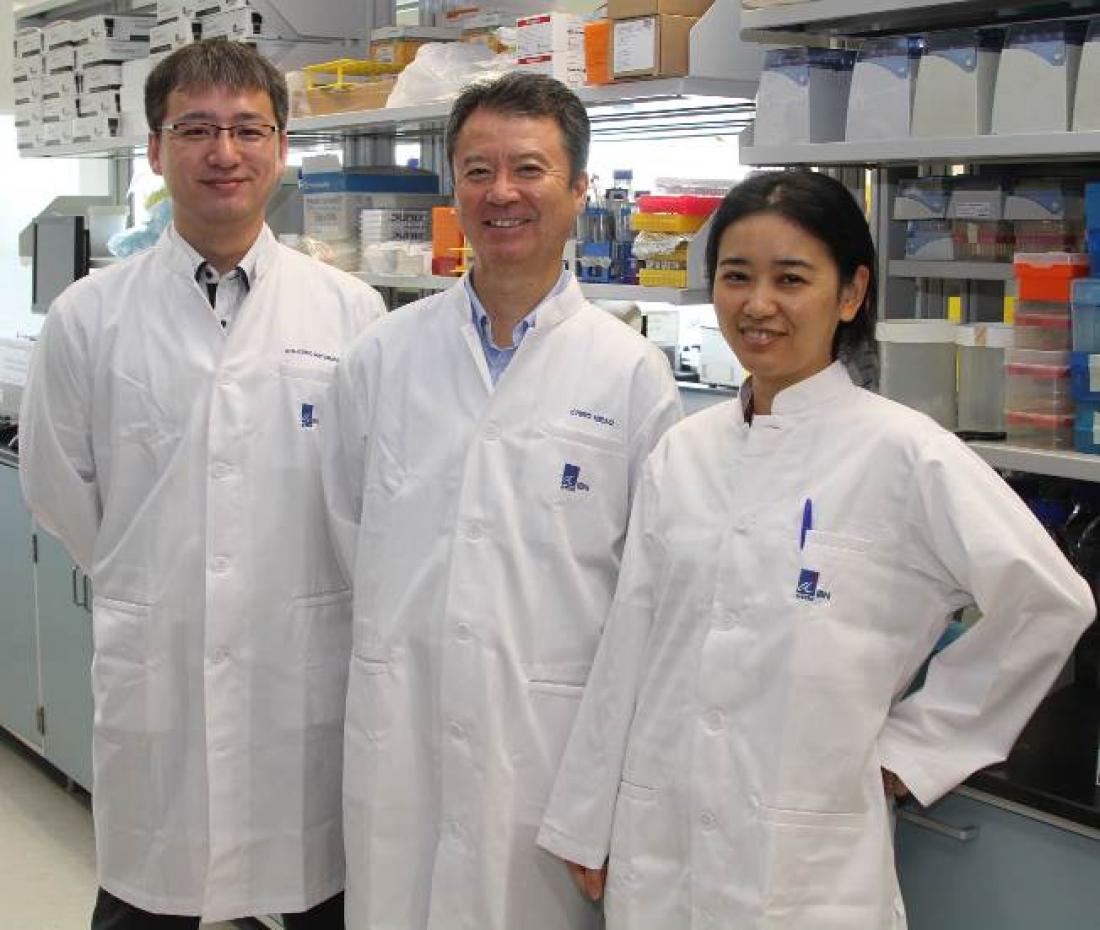The IBN researchers who invented the more efficient DNA aptamer technology (from left: Mr Ken-ichiro Matsunaga, Dr Ichiro Hirao and Dr Michiko Kimoto).
Singapore, February 1, 2016 – A more efficient DNA technology to detect and treat infectious diseases and cancer has been developed by researchers at the Institute of Bioengineering and Nanotechnology (IBN) of A*STAR.The researchers improved on existing technologies to create a modified single-stranded DNA molecule called aptamer. DNA aptamers are ideal for pharmaceutical applications because they can specifically bind to any molecular target in the body such as proteins, viruses, bacteria and cells.
Once DNA aptamers are artificially generated for each target, they will bind to it and inhibit its activity. This makes DNA aptamers a promising technology for disease detection and drug delivery. But no DNA aptamers have been approved for clinical use yet because current aptamers do not bind well to molecular targets and are easily digested by enzymes.
“To overcome these challenges, we have created a DNA aptamer with strong binding ability and stability with superior efficacy. We hope to use our DNA aptamers as the platform technology for diagnostics and new drug development,” said IBN Executive Director Professor Jackie Y. Ying.
This study, led by IBN Principal Research Scientist and Team Leader Dr Ichiro Hirao, was recently published in the journal, Scientific Reports.
To tackle the weak binding problem, the research team added a new artificial component called unnatural base to a standard DNA aptamer, which typically has four components. The addition of the fifth component greatly enhanced the binding ability to the molecular target by 100 times as compared to conventional DNA aptamers. Furthermore, to prevent the aptamer from being digested easily by enzymes, a unique and small DNA called ‘mini-hairpin DNA’ was added to the DNA aptamer.
Dr Hirao explained, “The mini-hairpin DNAs have an unusually stable and compact stem-loop structure, like a hairpin, of small DNA fragments. Their structure strongly resists the digestive enzymes, so I added them to specific positions on the DNA aptamer to act as a protective shield. Usually DNAs are digested within one hour in blood at body temperature. With the mini-hairpin DNA, our DNA aptamers can survive for days instead of hours. This is important for pharmaceutical applications, which require the therapeutic to remain in the body for a longer period.”
If successfully commercialized, DNA aptamers could replace or complement the existing use of antibodies in drugs for targeted disease treatment. Like aptamers, antibodies bind to targets in the body, but often cause undesirable immune response and are not easy to mass produce with high quality.
“We can now generate very promising DNA aptamers for clinical use. Our aptamers are more efficient, and lower in cost and toxicity compared to conventional methods. The next step of our research is to use the aptamers to detect and deactivate target molecules and cells that cause infectious diseases, such as dengue, malaria and Methicillin-resistant Staphylococcus aureus, as well as cancer,” added Dr Hirao.
END
Reference:
1. K. Matsunaga, M. Kimoto, C. Hanson, M. Sanford, H. A. Young and I. Hirao, “Architecture of High-Affinity Unnatural-Base DNA Aptamers Toward Pharmaceutical Applications,” Scientific Reports, 5 (2015) 18478.
Media Contacts:
Elena Tan Nidyah Sani
Phone: +65 6824 7032 Phone: +65 6824 7005
Email: [email protected] Email: [email protected]
About the Institute of Bioengineering and Nanotechnology (IBN)
The Institute of Bioengineering and Nanotechnology (IBN) is the world’s first bioengineering and nanotechnology research institute. Established in 2003, IBN’s mission is to conduct multidisciplinary research across science, engineering, and medicine for breakthroughs to improve healthcare and quality of life. IBN’s research activities are focused on Nanomedicine, Synthetic Biosystems, Biodevices and Diagnostics, and Green Chemistry and Energy. The Institute has published over 1,000 papers in leading scientific journals, filed over 300 active patents and patent applications on its inventions, and established 9 spin-off companies. To nurture young research talents, IBN runs a Youth Research Program that offers students research attachment opportunities and exposure to biomedical research.
For more information on IBN, please visit www.ibn.a-star.edu.sg.
About the Agency for Science, Technology and Research (A*STAR)
The Agency for Science, Technology and Research (A*STAR) is Singapore's lead public sector agency that fosters world-class scientific research and talent to drive economic growth and transform Singapore into a vibrant knowledge-based and innovation-driven economy.
In line with its mission-oriented mandate, A*STAR spearheads research and development in fields that are essential to growing Singapore’s manufacturing sector and catalyzing new growth industries. A*STAR supports these economic clusters by providing intellectual, human and industrial capital to its partners in industry.
A*STAR oversees 18 biomedical sciences and physical sciences and engineering research entities, located in Biopolis and Fusionopolis, as well as their vicinity. These two R&D hubs house a bustling and diverse community of local and international research scientists and engineers from A*STAR’s research entities as well as a growing number of corporate laboratories.
For more information on A*STAR, please visit www.a-star.edu.sg.



